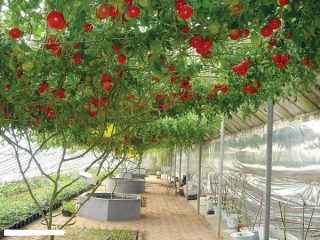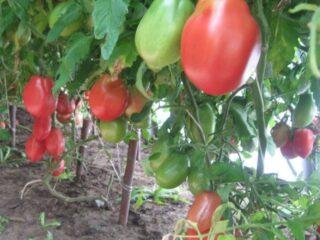Content
The Yetina mother tomato is a new promising variety that has already managed to make itself known. It is characterized by undemandingness, high yield and excellent taste. This species shows good productivity even in unfavorable seasons for the crop. But for this you need to follow the rules of agricultural technology.

Tomato Yetina mother is suitable for open ground and greenhouses
Who developed the variety and when?
This tomato appeared on the market in 2022. Its originator is the company Semyon Altai, which specializes in breeding types of vegetables adapted to the Siberian climate.
The variety is not included in the State Register. Its name is associated with an unusual story. As a result of selection, the tomato bushes turned out to be squat and shaggy, similar to the mythical northern inhabitant - the Yeti. And it so happened that a titmouse managed to build a nest on their shoots, which was subsequently scared away by the scientists.As a result, the bird flew away, but the tomato bushes carefully covered its clutch with shoots, like a mother. This ultimately led to the variety receiving a double name.
Description of the tomato variety Yetina mother
The tomato is a determinate species, so its main stem eventually ends in a flower raceme, which causes the plant to stop growing. The height of the bush of the Yetina mother tomato variety reaches 60-90 cm, depending on the growing conditions. The plants are well leafy and have thickened shoots, which makes this species stand out from other tomatoes. The variety does not require pinching. It can be grown by tying it to a support or as a creeping crop.
The leaves are standard, medium in size, dark green in color with a matte surface. The inflorescence is simple, the stalk is small. The first fruit cluster is placed above the 6-7th leaf, and then every 1-2. Each of them subsequently forms from five to seven different-sized ovaries.
The fruits are round, weighing 130-220 g. The skin is thin, dense, and does not crack. The pulp is sweetish, not watery, without hard fibers, and has a pronounced tomato taste and aroma. The fruits are distinguished by small seed chambers. When cut, the juice does not flow out of them. During the ripening process, tomatoes acquire a uniform red tint without a white spot at the stalk.

Tomatoes have a sweet taste without acid
Characteristics of Yetina mother tomatoes
You can evaluate the productivity of a tomato only by studying its basic characteristics. They allow you to compare it with other tomatoes and understand what its advantages are.
Ripening time
The Yetina mother tomato variety belongs to the mid-season category. Fruit ripening occurs 100-115 days after emergence. The first tomatoes on the bush reach consumer ripeness in a greenhouse at the end of July, and in open ground in the first ten days of August.
Tomato productivity Yetina mother
The species is highly productive. From one bush you can get 4 kg of marketable fruit. But if all growing recommendations are followed, this figure can be increased to 6 kg.

The tomato tasting score is 4.7 points out of a possible 5
Resistance to adverse factors
The species has increased resistance to such common crop diseases as fusarium, verticillium wilt and blossom end rot. It is also not susceptible to late blight, but in cool, rainy summer conditions, damage is possible. Therefore, when growing a Yetina tomato, you should not ignore preventive treatments of the bushes with fungicides.
In what regions is it grown?
According to the originator, the tomato tolerates drought, heat and temperature changes well. Therefore, it shows consistently high productivity in all regions of the country.
Methods of application
Thanks to the sweetish taste of tomatoes, the crop is excellent for fresh consumption, as well as for preparing summer salads with herbs. And due to the variety of fruit sizes, some specimens can be used for whole-fruit preservation. This is also facilitated by the fact that the skin remains intact during heat treatment.
Other possible uses of the crop:
- lecho;
- paste;
- pickling;
- drying;
- freezing
Advantages and disadvantages
Tomato has both strengths and weaknesses. Therefore, it is worth familiarizing yourself with them in advance so that problems do not arise later.

The seeds of this tomato can be used for planting
Main advantages:
- high productivity;
- possibility of ripening;
- versatility of application;
- excellent taste;
- does not require pinching;
- unpretentiousness;
- resistance to common diseases;
- absence of a white spot on the stalk;
- possibility of cultivation in all regions of the country;
- good presentation;
- tolerates transportation and long-term storage well;
- low sensitivity to temperature changes.
Flaws:
- crumbling of ripe tomatoes;
- variety of fruit sizes;
- not suitable for juice.
Landing nuances
It is recommended to grow this tomato in seedlings, which allows you to significantly speed up harvesting. By the time the seedlings are planted in a permanent place, their age should be 50-55 days. Therefore, it is recommended to sow the variety at home in early to mid-March.
To do this, you need to prepare a wide container, 15-20 cm high, with drainage holes and fill them with a loose nutrient substrate consisting of turf, sand, humus and leaf soil in a ratio of 2:1:1:1. The recommended seed planting depth for the Yetina mother variety is 0.5-1 cm. After planting, the soil mixture should be well moistened and the container covered with film or glass, and then moved to a dark place with a temperature of +22-23 °C.
If all conditions are met, friendly sprouts appear within 5-7 days. After this, the container should be moved to a bright windowsill and the maintenance regime should be reduced to +18-20 °C, and the daylight hours should be ensured for at least 12 hours.When the tomato seedlings become stronger, they need to be adapted to external conditions and the film or glass must be completely removed.
At the age of two true leaves, tomato seedlings need to be planted in separate pots, and after 10 days, fertilize with mineral fertilizer Kemira Lux or nitroammophoska.
Caring for seedlings at home also involves periodic watering at the root as the top layer of soil dries out.
Tomatoes can be planted in a greenhouse at the end of April or at the beginning of May, and in open ground only at the end of spring. During the procedure, it is recommended to deepen the seedlings to the first leaves to develop a powerful root system. The recommended planting scheme for this variety is 3-4 pcs. per 1 sq. m.

The yield of marketable fruits of the Yetina mother variety is more than 95%
Care instructions
This type of culture is unpretentious. Tomatoes should be watered 1-2 times a week, soaking the soil up to 20 cm. In this case, irrigation is carried out at the root, excluding moisture from getting on the leaves.
Tomato Yetina mother responds well to feeding. It needs to be fertilized during the formation of bushes, using organic matter and mineral mixtures with a high nitrogen content, as well as during flowering and ovary, using phosphorus-potassium preparations.
When growing, it is recommended to prevent the root system from drying out during hot periods. To do this, you need to lay peat mulch up to 3 cm thick at the base of the bushes.
Formation of tomato Yetina mother
Yetina mother tomatoes need to be formed only when growing the variety in a greenhouse. This is necessary for the formation of compact plants.To do this, the bushes need to be grown into 2-3 stems, and growing stepsons should be removed in a timely manner.
Pest and disease control
Throughout the growing season, it is recommended to periodically spray tomatoes with fungicides to protect against late blight. To do this, you can use such products as Ridomil Gold, Cuprozan, Quadris, Shavit, Tattu. The required frequency of treatments is every 10-14 days. During subsequent sprayings, protective equipment must be alternated.
This tomato may suffer from aphids and whiteflies. Therefore, if signs of damage appear, it is recommended to spray the bushes with Teppeki.

Lack of fertilizing reduces the immunity of the tomato Yetina mother
Conclusion
The Yetina mother tomato has characteristics that gardeners value so much. Therefore, it has every chance to compete with other similar types of crops. Although the variety has not yet been included in the State Register, there are already positive reviews about it.
Reviews from gardeners about the tomato variety Yetina mother








